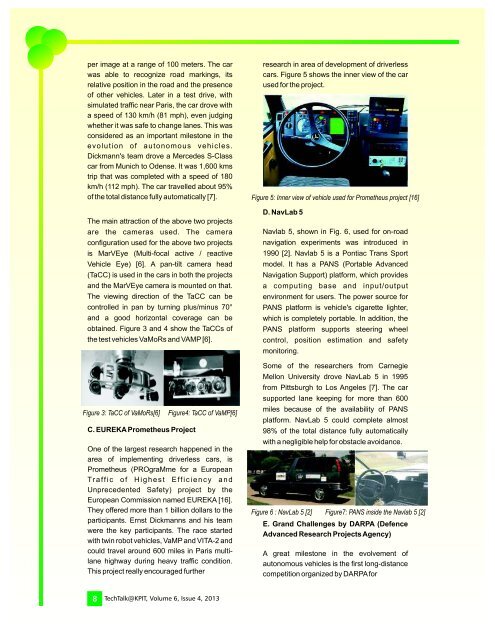Autonomous Vehicles - KPIT
Autonomous Vehicles - KPIT
Autonomous Vehicles - KPIT
You also want an ePaper? Increase the reach of your titles
YUMPU automatically turns print PDFs into web optimized ePapers that Google loves.
per image at a range of 100 meters. The car<br />
was able to recognize road markings, its<br />
relative position in the road and the presence<br />
of other vehicles. Later in a test drive, with<br />
simulated traffic near Paris, the car drove with<br />
a speed of 130 km/h (81 mph), even judging<br />
whether it was safe to change lanes. This was<br />
considered as an important milestone in the<br />
evolution of autonomous vehicles.<br />
Dickmann's team drove a Mercedes S-Class<br />
car from Munich to Odense. It was 1,600 kms<br />
trip that was completed with a speed of 180<br />
km/h (112 mph). The car travelled about 95%<br />
of the total distance fully automatically [7].<br />
The main attraction of the above two projects<br />
are the cameras used. The camera<br />
configuration used for the above two projects<br />
is MarVEye (Multi-focal active / reactive<br />
Vehicle Eye) [6]. A pan-tilt camera head<br />
(TaCC) is used in the cars in both the projects<br />
and the MarVEye camera is mounted on that.<br />
The viewing direction of the TaCC can be<br />
controlled in pan by turning plus/minus 70°<br />
and a good horizontal coverage can be<br />
obtained. Figure 3 and 4 show the TaCCs of<br />
the test vehicles VaMoRs and VAMP [6].<br />
Figure 3: TaCC of VaMoRs[6]<br />
C. EUREKA Prometheus Project<br />
Figure4: TaCC of VaMP[6]<br />
One of the largest research happened in the<br />
area of implementing driverless cars, is<br />
Prometheus (PROgraMme for a European<br />
Tr a ff i c o f H i g h e s t E ff i c i e n c y a n d<br />
Unprecedented Safety) project by the<br />
European Commission named EUREKA [16].<br />
They offered more than 1 billion dollars to the<br />
participants. Ernst Dickmanns and his team<br />
were the key participants. The race started<br />
with twin robot vehicles, VaMP and VITA-2 and<br />
could travel around 600 miles in Paris multilane<br />
highway during heavy traffic condition.<br />
This project really encouraged further<br />
research in area of development of driverless<br />
cars. Figure 5 shows the inner view of the car<br />
used for the project.<br />
Figure 5: Inner view of vehicle used for Prometheus project [16]<br />
D. NavLab 5<br />
Navlab 5, shown in Fig. 6, used for on-road<br />
navigation experiments was introduced in<br />
1990 [2]. Navlab 5 is a Pontiac Trans Sport<br />
model. It has a PANS (Portable Advanced<br />
Navigation Support) platform, which provides<br />
a computing base and input/output<br />
environment for users. The power source for<br />
PANS platform is vehicle's cigarette lighter,<br />
which is completely portable. In addition, the<br />
PANS platform supports steering wheel<br />
control, position estimation and safety<br />
monitoring.<br />
Some of the researchers from Carnegie<br />
Mellon University drove NavLab 5 in 1995<br />
from Pittsburgh to Los Angeles [7]. The car<br />
supported lane keeping for more than 600<br />
miles because of the availability of PANS<br />
platform. NavLab 5 could complete almost<br />
98% of the total distance fully automatically<br />
with a negligible help for obstacle avoidance.<br />
Figure 6 : NavLab 5 [2] Figure7: PANS inside the Navlab 5 [2]<br />
E. Grand Challenges by DARPA (Defence<br />
Advanced Research Projects Agency)<br />
A great milestone in the evolvement of<br />
autonomous vehicles is the first long-distance<br />
competition organized by DARPA for<br />
8 TechTalk@<strong>KPIT</strong>, Volume 6, Issue 4, 2013


